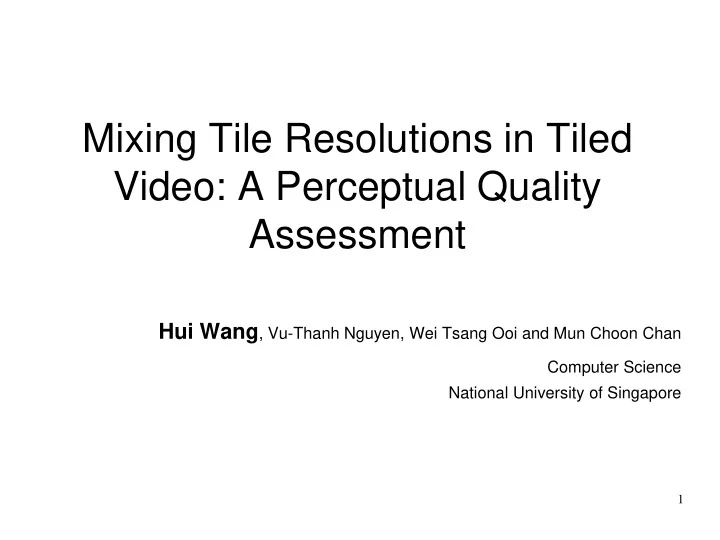

Mixing Tile Resolutions in Tiled Video: A Perceptual Quality Assessment Hui Wang , Vu-Thanh Nguyen, Wei Tsang Ooi and Mun Choon Chan Computer Science National University of Singapore 1
Rush-Hour V1
Rush-Hour V2
Background of tiled video 4
Benefits of tiled video 5
Inefficiency of wireless transmissions with multiple users Multiple transmissions for one tile 6
Mixing tile resolutions (Reduce transmissions) Highest quality among all requests 7
Mixing tile resolutions (Reduce bandwidth) Unpopular tile with lower quality 8
Perceptual quality assessment • The perceptual quality impact of mixing tiles with different resolutions • Psychophysical experiment: method of limits Gradually change tile resolutions to identify the Just Noticeable Difference (JND) and Just Unacceptable Difference (JUD) thresholds 9
Video 1: Crowd-Run (Dense Motion) 10
Video 2: Old-Town-Cross (Medium Motion) 11
Video 3: Rush-Hour (Low Motion) 12
Video resolutions, number of tiles, tile resolutions 𝟐𝟕 × 𝟘 tiles 𝟗𝟏 × 𝟓𝟔 tiles level frame 5 1920 × 1080 120 × 120 24 × 24 4 1600 × 900 100 × 100 20 × 20 3 1280 × 720 80 × 80 16 × 16 2 960 × 540 60 × 60 12 × 12 1 640 × 360 40 × 40 8 × 8 13
Constructing mixed-resolution tiled video Given configuration ( 𝑆 𝐼 , 𝑆 𝑀 ), randomly mixing tiles with resolution levels 𝑆 𝐼 and 𝑆 𝑀 14
Procedure 50 participants 12 stimuli series Each stimuli series is randomly descending or ascending 15
Descending Stimuli Series Rating pair (5, 5) and (5, 𝑆 𝑀 ): • i. Is the quality difference noticeable? ii. Is the quality difference unacceptable? Decreasing 𝑆 𝑀 from 4 to 1 or until the quality • difference is unacceptable 16
Ascending Stimuli Series Rating pair (5, 5) and (5, 𝑆 𝑀 ): • i. Is the quality difference noticeable? ii. Is the quality difference unacceptable? Increasing 𝑆 𝑀 from 1 to 4 or until the quality • difference is unnoticeable 17
CDF distribution of participants that cannot notice any difference between tiled video (5, R L ) and tiled video (5, 5) Crowd-Run Old-Town-Cross Rush-Hour 1 0.8 0.6 CDF 0.4 0.2 0 (5,1) (5,2) (5,3) (5,4) (5,5) R L Video Configuration (5, ) 18
Average Just Noticeable Difference threshold with 95% Confidence Interval value (Dense Motion) (Medium Motion) (Low Motion) 3.68 (±0.52) 3.25 (±0.47) 0.81 (±0.23) Average JND 𝑆 𝐼 = 5, (1920 × 1080) 𝑆 𝐼 = 5, (1920 × 1080) 𝑆 𝐼 = 5, (1920 × 1080) Mixing 𝑆 𝑀 = 4, (1600 × 900) 𝑆 𝑀 = 4, (1600 × 900) 𝑆 𝑀 = 1, (640 × 360) Resolutions Bandwidth 15.6% 18.7% 41.2% Reduction 19
CDF distribution of participants that accept the quality difference between tiled video (5, R L ) and tiled video (5, 5) Crowd-Run Old-Town-Cross Rush-Hour 1 0.8 0.6 CDF 0.4 0.2 0 (5,1) (5,2) (5,3) (5,4) (5,5) R L Video Configuration (5, ) 20
Average Just Unacceptable Difference threshold with 95% Confidence Interval value (Dense Motion) (Medium Motion) (Low Motion) 2.03 (±0.31) 1.76(±0.27) 0 (0) Average JUD 𝑆 𝐼 = 5, (1920 × 1080) 𝑆 𝐼 = 5, (1920 × 1080) 𝑆 𝐼 = 5, (1920 × 1080) Mixing 𝑆 𝑀 = 3, (1280 × 720) 𝑆 𝑀 = 2, (960 × 540) 𝑆 𝑀 = 1, (640 × 360) Resolutions Bandwidth 24.7% 34.5% 41.2% Reduction 21
Impact of tile size (Dense Motion) (Medium Motion) (Low Motion) Average JND 3.68 (±0.52) 3.25(±0.47) 0.81 (±0.23) (16x9 tiles) Average JND 3.30 (±0.48) 3.04(±0.44) 0.76 (0.20) (80x45 tiles) Average JUD 2.03 (±0.31) 1.76(±0.27) 0 (0) (16x9 tiles) Average JUD 1.76(±0.29) 1.63(±0.25) 0 (0) (80x45 tiles) 22
Conclusion & Future work Save bandwidth consumption by mixing tiles with different resolutions without noticeable quality degradation or with noticeable but still acceptable quality degradation Intelligently determine the tile resolution based on content or user interests Optimally determine resolutions of each tile for each user, given the resource constraints 23
Recommend
More recommend